As an experienced trapper, I’ve used countless muskrat traps over the years and discovered which ones truly deliver results. Muskrats can cause significant damage to your property, especially around water features like ponds and lakes. In this comprehensive guide, I’ll share my top picks for the best muskrat traps in 2025, along with expert advice on how to use them effectively.
Quick Picks: Best Muskrat Traps
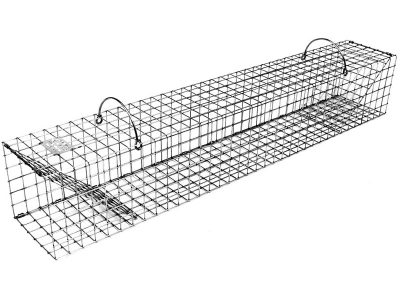
Editor’s Choice
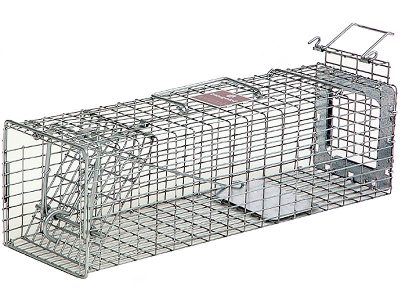
People’s Choice

Best Lethal Option
Understanding the Muskrat Problem
Muskrats are semi-aquatic rodents that can quickly become destructive pests on properties with ponds, lakes, or streams. These creatures measure about two feet long and are named for their rat-like appearance and distinctive musky odor. Despite their size, they can cause significant damage through their feeding and burrowing habits.
Habitat
Muskrats primarily live in lakes, rivers, ponds, and streams. They build burrows into banks or construct lodges from aquatic vegetation.
Diet
While primarily vegetarian, muskrats feed on aquatic plants, roots, stems, and occasionally salamanders, mussels, crayfish, frogs, and fish when vegetation is scarce.
Damage
Muskrats cause damage through destructive burrowing in dams, ponds, and streams, which can lead to leaks, runoff, and flooding. They also consume garden plants and damage shorelines.
Look for muskrat tracks, feeding platforms, droppings on elevated surfaces, burrow entrances (usually found underwater), collapsed banks, and leaking ponds or dams.

Typical muskrat habitat along water’s edge
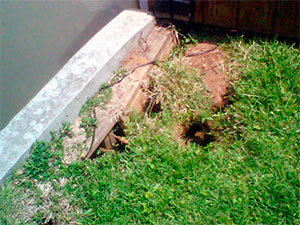
Bank damage from muskrat burrowing
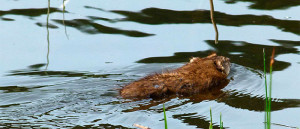
Adult muskrat swimming in natural environment
Best Muskrat Traps Reviewed
After years of trapping experience and extensive testing, I’ve identified the best muskrat traps currently available. Each has its own strengths depending on your specific situation and preferences.
Tomahawk Rigid Extra Long Muskrat Colony Trap
Editor's ChoiceHow Does It Work
How to Use
- Place the trap along muskrat runs, on paths near shorelines, or directly in front of burrow entrances
- Bait with apples, carrots, or parsnips placed in the center to attract muskrats
- Ensure the trap is level so the gravity-operated doors function properly
- Check the trap regularly to prevent unnecessary stress to captured animals
- When relocating captured muskrats, wear protective gloves and cover the trap with a cloth
- Extra-long 36-inch design can catch up to 10 muskrats at once
- Constructed from durable 14-gauge galvanized steel with rust-resistant finish
- Effective in both water and land settings
- Two gravity-operated doors maximize capture potential
- 1-inch x 1-inch wire mesh prevents escape while allowing visibility
- Larger size may make it challenging to transport and position in some areas
- Gravity-operated doors can be less effective when muskrats are swimming
- Higher price point than smaller traps
- Not adjustable for different muskrat sizes
For maximum effectiveness with the Tomahawk Colony Trap, place it halfway submerged in water along a known muskrat run. This placement ensures muskrats will encounter it during their normal travel patterns, significantly increasing your catch rate.
Safeguard Rear Release Live Cage Trap
People's ChoiceHow Does It Work
How to Use
- Position the trap along muskrat pathways or near their burrow entrances
- Bait with fresh vegetables like carrots or apples placed at the rear of the trap
- Ensure the trap is placed on a stable, level surface
- Check the trap at least once daily to prevent stress to captured animals
- Use the rear release door to safely release muskrats without handling them directly
- Rear release design makes releasing muskrats safer and easier
- Made from premium 16-gauge Galfan wire with superior rust resistance
- Compact size makes it easy to position in tight spaces
- Tight mesh pattern prevents escape
- Reliable spring-loaded door mechanism
- Single-door design may be less effective than double-door models for some situations
- Smaller size means capturing one muskrat at a time
- May require more frequent checking than colony traps
- Smaller muskrats can occasionally manipulate the trigger without setting it off
Ouell RM Outdoor Muskrat Trap
Best Lethal OptionHow Does It Work
How to Use
- Place the trap in areas with high muskrat activity—typically along their travel paths or near den entrances
- Position the trap with the open end facing the direction muskrats will approach from
- Set the trap according to the manufacturer's instructions, using the safety catch until final placement
- Secure the trap with wire or stakes to prevent it from being moved
- Check the trap regularly in accordance with local regulations
- Always wear protective gloves when handling and setting this trap
- Highly effective immediate results for serious infestations
- Compact size fits perfectly in muskrat runs
- Durable alloy steel construction for long-term use
- Integrated safety catch makes setting safer
- Quick, humane solution when used properly
- Requires proper training to set safely and effectively
- Not suitable for situations where live capture is preferred
- May require specific permits in some jurisdictions
- Potential risk to non-target animals if not properly placed
| Trap | Type | Size | Material | Best For |
|---|---|---|---|---|
| Tomahawk Colony Trap | Live Trap | 36″ x 6″ x 6″ | 14-Gauge Galvanized Steel | Large infestations, catching multiple muskrats |
| Safeguard Cage Trap | Live Trap | 18″ x 5″ x 5″ | 16-Gauge Galfan Wire | Easy release, single muskrat capture |
| Ouell RM Trap | Lethal Trap | 11″ x 5.5″ x 4″ | Alloy Steel | Immediate results, serious infestations |
Expert Guide: How to Trap Muskrats Successfully
Trapping muskrats effectively requires understanding their behavior and using the right techniques. Follow this comprehensive guide to maximize your success:
- Select the Right Trap Type
Consider your specific situation when choosing between live and lethal traps. Live traps are preferable if you plan to relocate the muskrats, while lethal traps may be necessary for severe infestations or where relocation isn’t practical. - Identify the Best Trap Locations
Look for signs of muskrat activity such as tracks, droppings, feeding platforms, or burrow entrances. The most effective placements include:– Along underwater paths (runs) used by muskrats
– Outside burrow entrances (typically located in the bank of waterways)
– Near feeding platforms or areas with muskrat damage
– Where water enters or exits a pond or stream
- Use Effective Bait
While muskrats are primarily vegetarians, certain baits work particularly well:– Fresh apple slices
– Carrots or parsnips
– Sweet corn
– Sweet potato pieces
– Oil of anise (as a scent attractant)
Position bait appropriately: at the end of single-door traps or in the center of double-door traps.
- Set Traps Properly
Follow the manufacturer’s instructions carefully. Ensure traps are:– Placed on level surfaces for proper door operation
– Firmly secured to prevent movement or floating away
– Positioned where muskrats will naturally encounter them
– Set with sensitive triggers adjusted properly
- Check Traps Regularly
Frequent monitoring is essential for both humane treatment of captured animals and trap effectiveness. Check at least once daily, preferably in the morning since muskrats are often active overnight.
Always wear heavy gloves when handling traps or captured muskrats. These animals can carry diseases and may bite when frightened. Follow all local regulations regarding the trapping and relocation of wildlife.
Understanding Live vs. Lethal Muskrat Traps
Choosing between live and lethal traps depends on your specific situation, local regulations, and personal preferences. Both options have distinct advantages and limitations:

Live Traps
- Capture muskrats without harm
- Allow for humane relocation
- Safe for non-target animals
- No risk to pets or children
- Comply with regulations in areas where lethal trapping is restricted
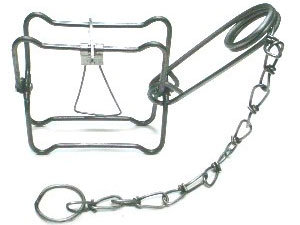
Body Grip Traps
- Quick, humane dispatch
- Effective for serious infestations
- No need for relocation
- Work well in underwater sets
- Compact and discreet placement
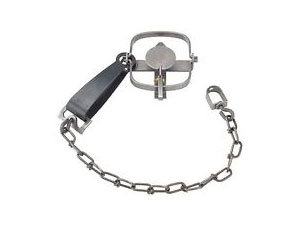
Leg Hold Traps
- Traditional trapping method
- Effective in various conditions
- Multiple size options
- Works well in spring sets
- Versatile placement options
Before using any lethal trap, verify your local wildlife regulations. Many jurisdictions have specific rules about trapping methods, seasons, and species. Some areas may require permits or have restrictions on certain trap types.
Effective Muskrat Trap Sets
Professional trappers use several proven set types to maximize muskrat captures. Here are the most effective approaches:
Spring Run Set
Place traps where small streams enter larger bodies of water. These natural funnels concentrate muskrat movement, making them ideal for foothold or body-grip traps.
Runway Set
Identify underwater paths used repeatedly by muskrats (visible as cleared channels in shallow water) and position colony or body-grip traps directly in these routes.
Slide Set
Also called “climb out sets,” these target locations where muskrats exit the water, leaving distinctive slides on the bank. Place foothold traps in the center of these paths.
Den Entrance Set
Position traps directly outside muskrat burrow entrances, which are typically found underwater along banks. This catches muskrats as they enter or exit their homes.
Advanced Trapping Tips
- Deploy multiple traps simultaneously across a larger area for faster results, as muskrat territories can extend up to 200 feet in diameter.
- Create a bait trail leading to your trap to increase curiosity and visitation rates.
- Avoid checking traps too frequently during the first 24 hours, as your scent may deter cautious muskrats.
- For colony traps in runs, position them so that less than half is submerged to keep captured muskrats alive if that’s your preference.
- Always secure traps properly to prevent them from being dragged away or floating off in water sets.
What to Do After Capturing Muskrats
Once you’ve successfully trapped muskrats, proper handling and either relocation or disposal is essential:
For Live-Captured Muskrats:
- Handle With Care: Always wear thick gloves when dealing with live muskrats to protect yourself from bites or scratches.
- Reduce Stress: Cover the trap with a cloth during transport to calm the animal.
- Choose an Appropriate Release Site: Relocate at least 5-6 miles away from your property in a suitable habitat with water access.
- Check Regulations: Some areas prohibit the relocation of wildlife, so verify local laws before proceeding.
For Lethal Traps:
- Proper Disposal: Follow local regulations for wildlife disposal. In many areas, burial is acceptable.
- Use Protective Equipment: Always wear gloves when handling animal remains, as muskrats can carry various diseases.
- Clean Traps Thoroughly: After use, clean and disinfect traps before storing or reusing them.
Prevention: Keeping Muskrats Away
While trapping is effective for existing muskrat problems, prevention is equally important for long-term control:
- Habitat Modification
Remove dense vegetation along banks that provides cover and food for muskrats. Maintain a 3-foot strip of closely mowed grass around water features. - Bank Protection
Install wire mesh or riprap along banks to prevent burrowing. Bury the material at least 12 inches deep and extend it 3 feet above and below the water line. - Water Level Management
Where possible, periodically adjust water levels in ponds and lakes. Fluctuating levels discourage muskrats from establishing permanent dens. - Regular Monitoring
Inspect banks and water features regularly for signs of new muskrat activity, especially during spring and fall when they’re most active.
Frequently Asked Questions
Are muskrats dangerous to humans?
Muskrats generally avoid human contact but may bite or scratch when cornered or handled. Their main threat is the property damage they cause through burrowing and feeding. They can also carry diseases like tularemia and leptospirosis, so always wear gloves when handling traps or animals.
What time of year is best for trapping muskrats?
Fall and early winter are typically the most productive seasons for muskrat trapping. During these periods, muskrats are actively preparing for winter by increasing their food consumption and reinforcing their dens, making them more likely to encounter traps.
How many traps should I use for a muskrat problem?
For effective control, use at least 3-5 traps for small ponds and up to 10-15 for larger water bodies. Since muskrat territories can span up to 200 feet in diameter with multiple entrances and feeding areas, multiple traps increase your chances of success.
Do I need a license to trap muskrats?
Licensing requirements vary by location. In many states and regions, trapping muskrats on your own property for nuisance control doesn’t require a license, but trapping for fur or on public lands often does. Always check with your local wildlife agency for specific regulations.
Can muskrats damage my pond or lake dam?
Yes, muskrat burrowing is particularly destructive to earthen dams, dikes, and pond banks. Their extensive tunnel systems can compromise structural integrity, leading to leaks, erosion, and potentially catastrophic failures. Serious infestations should be addressed promptly to prevent costly damage.
How do I tell the difference between muskrats and beavers?
Muskrats are much smaller (2-4 pounds) than beavers (35-70 pounds). Muskrats have thin, rat-like tails that are vertically flattened, while beavers have wide, horizontally flattened paddle-like tails. Muskrats also build smaller lodges and don’t create dams like beavers do.
Conclusion
Muskrat trapping doesn’t have to be complicated when you choose the right tools and techniques. The Tomahawk Rigid Extra Long Muskrat Colony Trap stands out as the most versatile and effective option for most situations, while the Safeguard Rear Release Cage Trap offers excellent ease of use. For those requiring immediate results with serious infestations, the Ouell RM Outdoor Muskrat Trap provides a humane lethal solution.
Remember that successful muskrat control combines effective trapping with proper habitat management and preventive measures. With the right approach, you can protect your property from the destructive impact of these persistent rodents.
For severe or persistent infestations that don’t respond to DIY trapping efforts, consider consulting with a professional wildlife control specialist who can provide targeted solutions for your specific situation.
